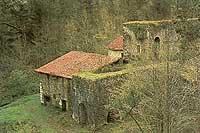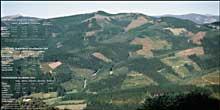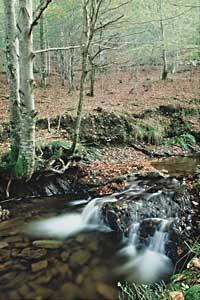Deaths reactivate the forest
2004/12/01 Agirre Ruiz de Arkaute, Aitziber - Elhuyar Zientzia Iturria: Elhuyar aldizkaria
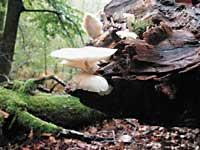
The forest of dead trees is not in decline. The corrupt trunks give life to the jungle, where in addition to fungi and mosses, many other animals have found their corner. Ants, coleoptera larvae and amphibians come to corrupt trunks in search of food to escape the cold or hide from predators.
Moreover, the small holes of the roots and the ancient trunks are also useful for many animals: the black beak nests and the sargo pancakes of the seeds, which in winter will be really usable. It is no wonder that dead logs contain more living biomass than when they were alive.
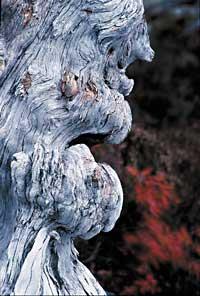
Fallen trees abound in natural forests and experts believe that in the forests of natural parks we would have to deposit as much rotten wood as in natural forests. Because they serve to increase biodiversity, and because as they rot they create humus and enrich the soil.
It is enough that there are landslides or that the rays strike hard to kill the trees and accumulate rotten wood in the forest. In addition to increasing biodiversity, they create clearings in the forest and make a txoko for young trees. Finally a mosaic of young, adult and rotten trees is formed. That is, a forest with a complex and rich structure. The problem is that in the forests used for the production of wood this type of complexity can hardly be achieved: matarrasa destroys diversity. And on the contrary, when the forest is full of bushes and fallen trunks, it is difficult to introduce the typical machinery of the forestry sector.
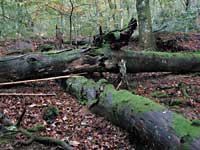
Therefore, management aimed at increasing biodiversity cannot be carried out in any forest. The simplest thing would be to do in protected forests, but experts on how to manage natural park forests do not agree. It should be clarified that to date in the Autonomous Community of the Basque Country, for example, there have been 14 protected areas with natural parks and biotopes. However, if the Basque Government's proposal to go to Europe to expand protected areas is accepted, 52 will soon be the places of community interest. And this has generated a debate, how will all these protected spaces be managed?
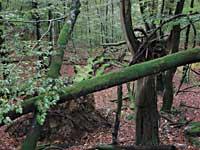
José Ramón Diez is a doctor in biology and, according to him, “the issue is that there are many ways to manage the forest and it is managed according to the objectives. The conservation of biodiversity, soil and hydrological cycle protection, leisure and satisfaction of the low demands of existing wood, are the objectives that the forest must meet. At another time the goal was to produce wood, but nowadays conservation must be the priority. It is advisable that the public forests of the natural parks are destined to it, but unfortunately the planning of the protection zones does not establish this same priority and do not establish measures to increase the complexity of the forest”. Meanwhile, the report published by WWF makes it clear that the biodiversity of European forests is in a critical situation.
Alejandro Cantero Amiano: “Now our goal is to regenerate wet beech forests through their seeds”
Alejandro Cantero is an ICT forestry engineer. In the last 14 years it has developed plans for the management of public and heritage mountains for the councils, especially the natural parks.
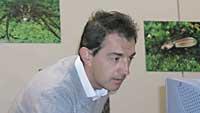
In the Autonomous Community of the Basque Country, for example, we have 60,000 hectares declared Natural Parks, of which two thirds are wooded. Most are native hardwood species. Tree plantations for wood production are not numerous. Gorbeia Natural Park is the largest: Of the 15,000 hectares of forest, 5,000 are pine forests of wood production. They also exist in Urkiola and Aiako Harria. But otherwise, the leafy ones predominate. In fact, the radiata does not grow well above 500-600 meters and most of our natural parks are concentrated in the vicinity of the mountains, in unproductive places.
Are these hardwood forests managed to preserve biodiversity or produce wood?No, no, the lush forests of the natural parks are not used to produce wood. It cuts very little beech, has not much demand. Hardwood forests are managed to conserve biodiversity.
And what kind of work is done in these forests?Right now we let the trees grow spontaneously. It is logical to think that biodiversity will come naturally if it is not cut in the forest.
However, we must understand the history of our forests, which are not like the Navarrese forests. They let them grow for many years and then cut them down the base to create new beech. In the CAPV they have been used for the manufacture of coal, narrow logs that were cut by the rear and grew in the form of buds. And the ground beeches were cut a couple of meters from the ground and become a candlestick: thick trunk and numerous ascending branches.
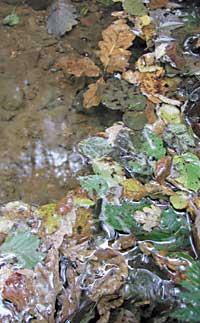
Today that wood is worthless, sawmills give nothing in return. Therefore, what we have to do is leave the main outbreak and remove the others so that in the long run one main trunk grows. Thus, the tree faces better plagues, hail, cold...
In short, we have to ensure the sustainability of the mountain and many of these beech trees are hundreds of years old, the rear and the roots are enormously old and often sick. Any plague can kill everyone without leaving offspring and losing the beech. Our goal is the regeneration of the forest through the seeds of these beech. Therefore, we are cutting the sprouts so that the main outbreak we leave can give seeds.
Most of the forests in Euskal Herria are monospecific. Do you manage it in the natural parks?No, nothing is done. It is true that in the beech forests there is only beech and therefore only fauna associated with beech. It is much more interesting beech with maples, holly, etc.
Analyzing the old pollen samples it has been proven that the beech from here first lived with other species, such as the spruce. I have ever proposed planting fir trees in some beech management. I would love to see the mixture of fir and pine in the beech trees. But many naturalists give a circular refusal claiming that they are exterior. What they do not have is that the beech also came from outside and later than the spruce.
What if there is dead wood in the woods?There is, but little. Less than 5% of total forest biomass is made up of dead or fallen logs in the soil. Very little compared to natural forests.
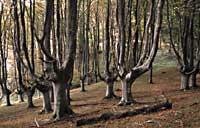
For some species there are sources of disease. For example, in pine forests and forest plantations in general, it is not advisable to have a lot of dead wood; they are insect farms. Therefore, they are compatible but if we leave little time dead wood.
And what do forest owners say? Do you accept such techniques?Yes, they are accepting. They have technical advisory staff in their associations and are gradually developing management plans for their forests, as they know that in this way they will receive grants and later receive the certificate of wood produced.
Just like the street people it costs more. Go to the forest and find anywhere fallen trunks crossed on the way, you can not walk easily. Visitors to the natural parks say that is a crap, a dirty forest. Visitors do not like virgin forests that naturalists like.
Jorge González Esteban: “The forests of Euskal Herria are functional deserts”
She holds a PhD in Biology and works in a consultant. He has made a diagnosis of the forests of several natural parks of Euskal Herria: De Bertiz, Aiako Harria, Aralar and Gorbea, among others.
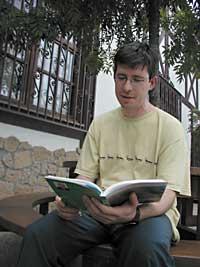
Forest cover is growing, but there are no real forests throughout the Basque Country. They are simple orchards. Whether it is barley, carrot or Pinus radiata. Like a year of cycle, 5 years or 40 years. In short, they are plantations that never reach maturity. For example, in the forest of Irati, the largest beech in Europe, a very efficient operation is carried out. Plant, grow and cut! We always force the forest to be young, it is shaken. And these forests have very limited structural diversity.
What consequences does the loss of structural diversity have?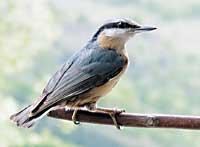
In a forest you need trees of various thicknesses and ages, old, decaying, totally rotten trees... This increases biodiversity by increasing resources. Here the red ant will be included in the list of animals to be protected and the larvae that inhabit the rotten wood are increasingly scarce. Consequently, also black birds that eat all of them.
We are also losing the whole community of amphibians: harps, toads, tritons... all are disappearing. The forest of Bertiz is the one with the greatest structural diversity, since for a hundred years man has not intervened. There are between 1,000 and 2,000 arrabios per hectare. But in the Aralar beech there are only 10-20 arrabios. And arrabio is one of the ecologically key species.
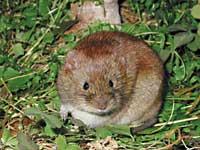
The forests here seem beautiful, aesthetically wonderful: that green leaf, long and white trunks... They have made us believe that they are beautiful. But there is extreme poverty, they are only orchards of trees. We are creating silent and sad forests. They are functional deserts.
Would having more dead wood solve the problem?In the Autonomous Community of the Basque Country there is practically no dead wood, being only branches and small logs. It is a very fine wood and rot too fast. Thick logs that rot slowly are needed. The problem is that we do not let the trees finish their full cycle, because we always cut them before arriving.
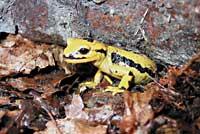
In addition, natural forests are not usually continuous wooded masses like those here. Wind and fires throw trees and create clearings. All these clearings allow young trees to grow, so they are natural ways of regeneration. If we want to generate biodiversity in our forests, we must influence them. Without waiting for it to happen on its own, we must act. Before being late we have to start growing the moorings, to grow the black birds...
But that doesn't give moneyRecently he has made an economic assessment of the natural resources that Navarre possesses: the assessment of the ravages... in short, of the species that houses them. He put a price on them. It provoked a great controversy, but it has served to make society see that all this is worth, has a lot of value. And surely more and more.
Do you consider the management currently carried out in the forests of natural parks appropriate?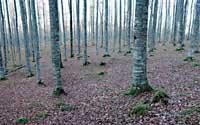
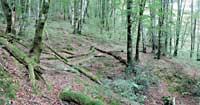
The protection regime of natural parks is negligible. They keep pulling wood. Only in Aiako Harria has it been determined that only natural vegetation will be installed in public forests. Elimination of conifers and introduction of leafy. But most have no absolute commitment. In Gorbeia, for example, there are only two reserves of 9,000 hectares of forest: A section of beech 25 ha and another 60 ha, with Mediterranean scrub and four oaks. This is all that the administration wants to leave in its natural evolution.
Only in Bertiz, Urbasa and others can we speak of parts in the form of forest. In Bertiz, for example, beech is impressive. There are trees of different sizes and ages: A 60-year-old beech, about 20, 100... From that moment on, between 15 and 20% of the trees are dead: fallen, rotten... But the forest is alive, the life there is incredible! There are trees over 150 years old, totally healthy and strong!
The Fontana Forest turned into an experimental laboratory
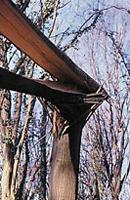
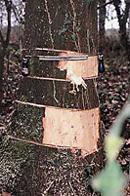
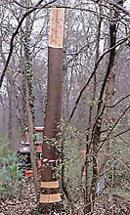
The Italians undertake a striking experiment in the Fontana nature reserve: they decide to imitate the violent effects that wind, snow, parasites and fire cause in the forests. That is, killing the trees. Somehow, all these phenomena that occur spontaneously for hundreds of years in natural forests, aim to influence a very short time to accelerate the development of the natural forest.
Only those brought from the outside - the American oaks - have been killed to help the native vegetation, but the very death of the trees has generated controversy: they have been cut and perforated intentionally so that the birds rot or nest; they have cut off the skin of many trees to imitate a tree that has been erected by a disease; others have cut the root cup. Moreover, they have been pruned with small explosions, as if the wind had thundered them; and when they feared that despite pruning they would sprout again, they have been cast into fungicides to die faster.
For some they are techniques too hard, brave and effective for others. In favor and against, no one has left himself indifferent. For the moment, the European Union has given the approval and financed the project in the hope that in a short time the forest will increase its spatial and structural complexity.
Would you use this technique here?
Jorge González Esteban:
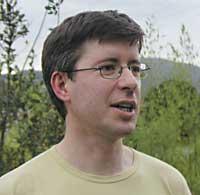
“Such experiments are necessary and here I am in favor of using these techniques. It is not about fires and explosions, but it is about cutting certain trees, making holes, etc. I would put up experimentation workshops in all natural parks: In Gorbeia, Izki, Urkiola, Aiako Harria... But not in the small and scattered reserves we have now, we need land over 300-400 hectares.
However, if techniques similar to Italian are used to increase biodiversity, it is evident that in these plantations we must forget the production of wood. Both activities are incompatible. What is clear is that more research is needed, because nothing is done here. We don’t have a database either: we almost don’t know what we have and that comes very well to some because we don’t know what we lose.”
Alejandro Cantero Amiano:
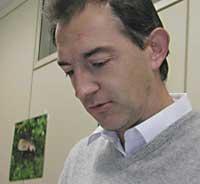
“These experiments seem dangerous to me, I am not a supporter of them. I think natural parks should be places of experimentation, but for beneficial experimentation. For example, if you notice that in a forest fir trees are planted and damaged, because they are a source of disease or whatever, fir trees are removed! You can retreat. But if the tree dies and does not work, we will need between 100 and 200 more years to recover it and experience it again. I would wait to see what results it gives the Italians.”

Gai honi buruzko eduki gehiago
Elhuyarrek garatutako teknologia




